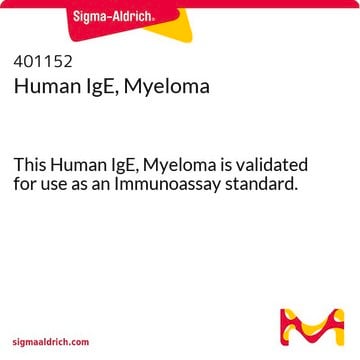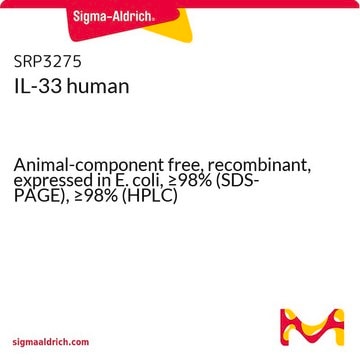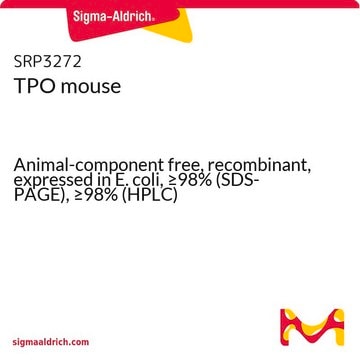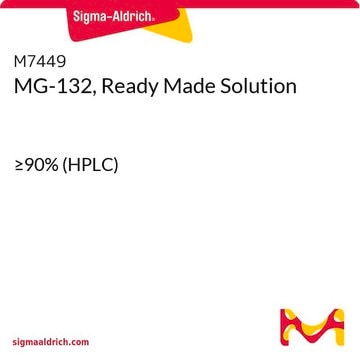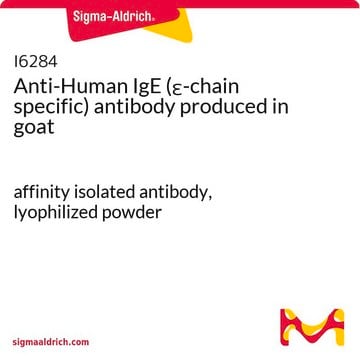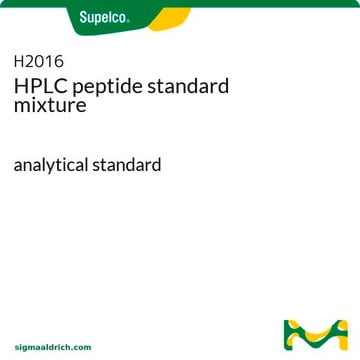SRP4193
IL-33 human
recombinant, expressed in E. coli, ≥98% (SDS-PAGE), ≥98% (HPLC)
Synonym(s):
C9orf26, DKFZp586H0523, DVS27, NF-HEV, NFEHEV, RP11-575C20
Sign Into View Organizational & Contract Pricing
All Photos(1)
About This Item
UNSPSC Code:
12352202
NACRES:
NA.32
Recommended Products
biological source
human
recombinant
expressed in E. coli
Assay
≥98% (HPLC)
≥98% (SDS-PAGE)
form
lyophilized
mol wt
~18.1 kDa
packaging
pkg of 10 μg
impurities
endotoxin, tested
NCBI accession no.
shipped in
wet ice
storage temp.
−20°C
Gene Information
human ... IL33(90865)
Related Categories
General description
IL-33 (interleukin 33) is a potent immunomodulatory cytokine that belongs to the IL-1 family, which also includes IL-1β and IL-18. This protein as first identified as a nuclear factor showing predominant expression in human high endothelial venules. IL-33 shows high expression levels in endothelial cells and epithelium, such as keratinocytes, that are in direct contact with the environment.
Recombinant human IL-33 produced from Escherichia coli is a non-disulfide-linked homodimeric, non-glycosylated polypeptide chain consisting of 160 amino acids and having a total molecular mass of 18.1kDa.
Recombinant human IL-33 produced from Escherichia coli is a non-disulfide-linked homodimeric, non-glycosylated polypeptide chain consisting of 160 amino acids and having a total molecular mass of 18.1kDa.
Biochem/physiol Actions
IL-33 (interleukin 33) functions as an extracellular cytokine, and also translocates to the nucleus where it inhibits gene expression. It acts as a ligand for ST2/ IL-1 receptor-like 1 (growth STimulation expressed gene 2), and ST2 is expressed on cells such as CD34+ hematopoietic progenitor cells, eosinophils, basophils, T-helper 2 cell (Th2), and dendritic, NK (natural killer), endothelial and mast cells. Polymorphisms in this gene as well as its receptor are linked with atopic dermatitis, allergies and asthma. This protein is also thought to function as a profibrogenic cytokine, signaling through ST2, where it facilitates the stimulation and progression of fibrosis in different types of organs and tissues, such as pulmonary, liver, and uterine leiomyoma. In renal transplant recipients, the increased levels of IL-33 might be implicated in the pathogenesis of chronic allograft dysfunction (CAD).
Physical form
Sterile filtered and lyophilized with 10 mM sodium phosphate, pH 7.5.
Reconstitution
Centrifuge the vial prior to opening. Avoid freeze-thaw cycles.
Reconstitute in water to a concentration of 0.1-1.0 mg/mL. The solution can then be diluted into other aqueous buffers.
Storage Class Code
11 - Combustible Solids
WGK
WGK 3
Flash Point(F)
Not applicable
Flash Point(C)
Not applicable
Certificates of Analysis (COA)
Search for Certificates of Analysis (COA) by entering the products Lot/Batch Number. Lot and Batch Numbers can be found on a product’s label following the words ‘Lot’ or ‘Batch’.
Already Own This Product?
Find documentation for the products that you have recently purchased in the Document Library.
The Potential Role of IL-33 in Renal Transplant Recipients with Chronic Allograft Dysfunction.
Zhang J et al
Annals of Transplantation : Quarterly of the Polish Transplantation Society, 21, 611-618 (2016)
Esophageal Epithelial-Derived IL-33 Is Upregulated in Patients with Heartburn.
Sei H et al
PLoS ONE, 11(4), e0154234-e0154234 (2016)
Elizabeth A Oczypok et al.
The Journal of allergy and clinical immunology, 136(3), 747-756 (2015-05-02)
Single nucleotide polymorphisms in the human gene for the receptor for advanced glycation end-products (RAGE) are associated with an increased incidence of asthma. RAGE is highly expressed in the lung and has been reported to play a vital role in
Targeting the IL-1 family members in skin inflammation.
Jensen LE
Current Opinion in Investigational Drugs, 11(11), 1211-1220 (2010)
Ying Lei et al.
PloS one, 10(7), e0133774-e0133774 (2015-07-28)
In several clinical and experimental studies IL-33 and its receptor have been found to play important roles in the development of asthma and allergic airway inflammation. We evaluated the effects of vaccination against IL-33 in a mouse model of airway
Our team of scientists has experience in all areas of research including Life Science, Material Science, Chemical Synthesis, Chromatography, Analytical and many others.
Contact Technical Service